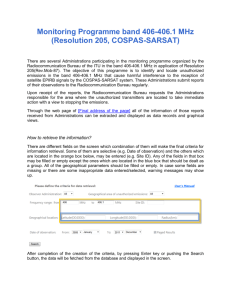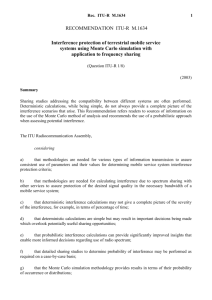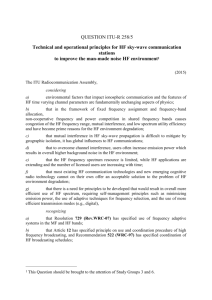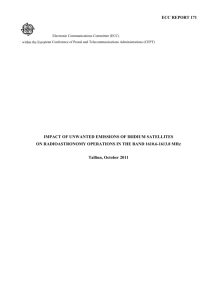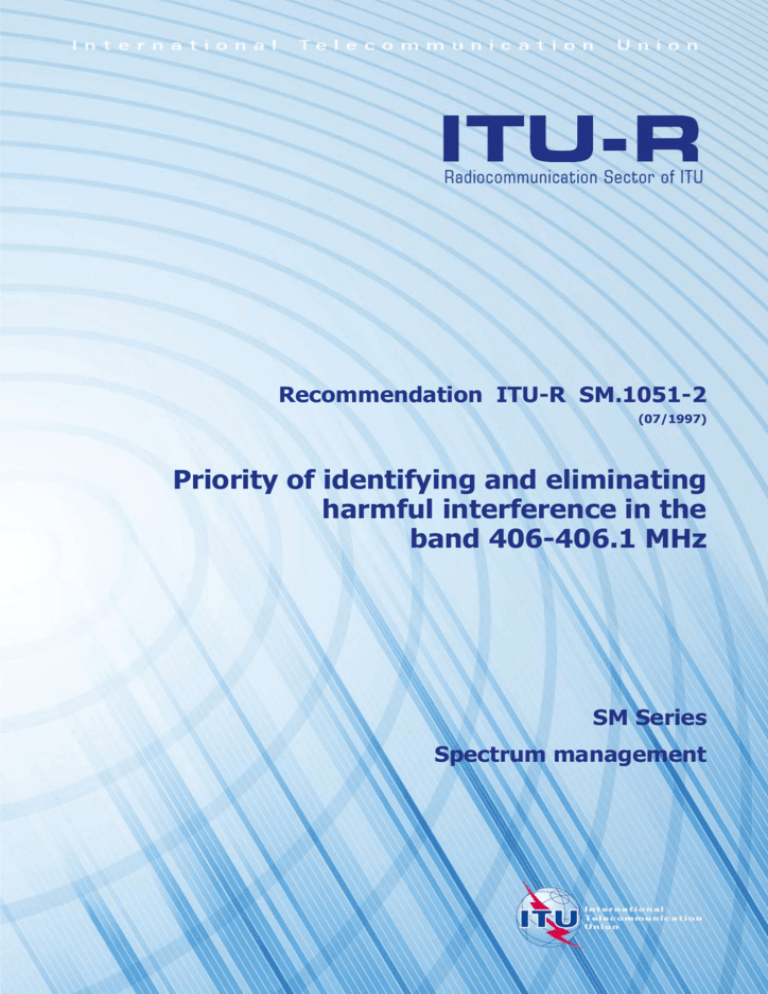
Recommendation ITU-R SM.1051-2
(07/1997)
Priority of identifying and eliminating
harmful interference in the
band 406-406.1 MHz
SM Series
Spectrum management
ii
Rec. ITU-R SM.1051-2
Foreword
The role of the Radiocommunication Sector is to ensure the rational, equitable, efficient and economical use of the
radio-frequency spectrum by all radiocommunication services, including satellite services, and carry out studies without
limit of frequency range on the basis of which Recommendations are adopted.
The regulatory and policy functions of the Radiocommunication Sector are performed by World and Regional
Radiocommunication Conferences and Radiocommunication Assemblies supported by Study Groups.
Policy on Intellectual Property Right (IPR)
ITU-R policy on IPR is described in the Common Patent Policy for ITU-T/ITU-R/ISO/IEC referenced in Annex 1 of
Resolution ITU-R 1. Forms to be used for the submission of patent statements and licensing declarations by patent
holders are available from http://www.itu.int/ITU-R/go/patents/en where the Guidelines for Implementation of the
Common Patent Policy for ITU-T/ITU-R/ISO/IEC and the ITU-R patent information database can also be found.
Series of ITU-R Recommendations
(Also available online at http://www.itu.int/publ/R-REC/en)
Title
Series
BO
Satellite delivery
BR
Recording for production, archival and play-out; film for television
BS
Broadcasting service (sound)
BT
Broadcasting service (television)
F
Fixed service
M
Mobile, radiodetermination, amateur and related satellite services
P
Radiowave propagation
RA
Radio astronomy
RS
Remote sensing systems
S
Fixed-satellite service
SA
Space applications and meteorology
SF
Frequency sharing and coordination between fixed-satellite and fixed service systems
SM
SNG
Spectrum management
Satellite news gathering
TF
Time signals and frequency standards emissions
V
Vocabulary and related subjects
Note: This ITU-R Recommendation was approved in English under the procedure detailed in Resolution ITU-R 1.
Electronic Publication
Geneva, 2010
ITU 2010
All rights reserved. No part of this publication may be reproduced, by any means whatsoever, without written permission of ITU.
Rec. ITU-R SM.1051-2
1
RECOMMENDATION ITU-R SM.1051-2*
PRIORITY OF IDENTIFYING AND ELIMINATING HARMFUL
INTERFERENCE IN THE BAND 406-406.1 MHz
(1994-1995-1997)
Rec. ITU-R SM.1051-2
The ITU Radiocommunication Assembly,
considering
a)
that the band 406-406.1 MHz has been allocated in the Radio Regulations (RR) to the mobile-satellite
(Earth-space) service for use by emergency position-indicating radio beacons (EPIRBs) in cases of distress or emergency;
b)
that administrations may also authorize use of personal locator beacons, emergency locator transmitters, or
equivalent systems, on a national basis using transmitter radiation parameters and characteristics similar to those
of EPIRBs;
c)
that as part of the Global Maritime Distress and Safety System, the International Maritime Organization has
required carriage of EPIRBs aboard ships operating under the Safety of Life at Sea Convention;
d)
that the purpose of EPIRBs and equivalent systems is to facilitate search and rescue operations by means of
satellite locating techniques;
e)
that the use of satellite EPIRBs and related satellite systems is designed to save lives by efficiently bringing
rescue services quickly and directly to those in distress;
f)
that satellite receivers reveal the presence of many signals causing harmful interference in the band
406-406.1 MHz in various regions of the Earth;
g)
that interference be eliminated immediately because the presence of any interference leads to deterioration in
the search and rescue satellite system which works on the basis of statistical processing of low-power signals and that
such interference may threaten the safety of life or property;
h)
that severe interference in the band 406-406.1 MHz has already been shown to be able to completely mask
EPIRB transmissions over ocean areas covering thousands of square kilometres;
j)
that Article 15 of the RR establishes a procedure for administrations to communicate directly to resolve
interference problems;
k)
that the Radiocommunication Bureau (BR) has a programme to coordinate reports of interference in the band
406-406.1 MHz on a worldwide basis and can intervene when the procedures in § j) are not feasible to communicate
reports to appropriate administrations, requesting their assistance in eliminating such interference;
l)
that national radio monitoring services may be in a good position to assist in detecting, localizing, and
identifying interference sources in this band and thereby significantly contribute to protection of life and property;
m)
that feedback on the located source of interference provides valuable information that may be useful in
eliminating and preventing future interference problems,
recommends
1
that administrations should immediately locate and eliminate interference in the band 406-406.1 MHz when
notified of the interference;
2
that full use be made of available monitoring and direction-finding capabilities to detect, localize, identify and
eliminate radio interference in the band 406-406.1 MHz on a priority basis;
3
that administrations having the capability for monitoring and identifying interference in the band
406-406.1 MHz are strongly urged to participate and report regularly to the BR;
_______________
*
Radiocommunication Study Group 1 made editorial amendments to this Recommendation in 2010 in accordance with
Resolution ITU-R 1-5.
2
Rec. ITU-R SM.1051-2
4
that administrations should install and operate local user terminals (LUTs) for detecting emergency distress
signals and interference. This will provide coverage in areas presently unserved;
5
that the information regarding the operation of EPIRBs and the associated satellite processing systems given in
Annex 1 should be used as an aid to eliminating interference in this band;
6
that reporting administrations communicate on a priority basis and include information as set forth in Annex 2;
7
that administrations provide feedback to the reporting administration and the BR as set forth in Annex 3.
ANNEX 1
Operation of the Cospas-Sarsat 406 MHz system
1
Principle of 406 MHz EPIRB detection and location
Once activated, a 406 MHz EPIRB transmits a 0.5 s burst every 50 s (see Recommendation ITU-R M.633). A digital
message containing identification data is modulated onto the burst. EPIRBs transmit independently of each other,
resulting in random timing between bursts from different EPIRBs.
The frequency of each received burst is measured by a receiver-processor aboard the Cospas-Sarsat satellites. The
frequency is stored, along with the time of reception and the identification data, and this information is retransmitted to
Cospas-Sarsat ground stations around the world.
The position of each EPIRB is calculated by the ground stations using the frequencies and times obtained from the
satellite, and the satellite position at each of the burst times. This calculation is based on the well-known Doppler effect
which relates the received burst frequency to the satellite's relative speed.
The first generation satellite receiver-processors have an input bandwidth of 25 kHz, centred on 406.025 MHz and
second generation instruments have input bandwidths selectable up to 80 kHz, centred at 406.05 MHz.
In addition to having on-board receiver-processors, some polar orbiting satellites are also equipped with repeaters to relay
transmissions in the 406-406.1 MHz band directly to ground stations for further processing. The time and frequency
measurements are made by the ground station and the location is then determined in a manner similar to that described
above. Some geostationary satellites are also equipped with such repeaters, which allow 406 MHz signals to be detected,
but not located due to the lack of a significant Doppler shift.
2
Processing 406 MHz interference signals
Any signals in the 406-406.1 MHz band which are not transmitted by EPIRBs can interfere with the detection of real
EPIRB signals. Such interfering signals are not necessarily produced by transmitter-operating in the 406-406.1 MHz
band, but can result from out-of-band emissions, sidebands, spurious emissions or harmonics falling in the
406-406.1 MHz band from transmitters operating at other frequencies.
In accordance with Resolution No. 205 of the World Administrative Radio Conference for the Mobile Services
(Geneva, 1983) (WARC MOB-83), administrations were invited to monitor and report on such interference.
This requires installation of a LUT having the capability to monitor signals received from the space station. Sources of
harmful interference received at the LUT can be used to fix the origin of the interference. It is after the detection of such
interference and notification to the appropriate administration by the BR, that terrestrial monitoring facilities can locate
the precise station causing the interference.
Rec. ITU-R SM.1051-2
3
406 MHz interferers generally transmit continuous signals for a long period of time compared to the half-second EPIRB
bursts. Like the EPIRB signals, these near-continuous signals exhibit a Doppler frequency variation that can be used to
compute the interferer location. Unlike the processing of EPIRB emissions, no identification code can be extracted from
an interfering signal, since its modulation, if any, would not be in the correct format. Interference sources must be
identified by spectrum shape-recognition techniques.
The 406 MHz repeater on the Sarsat satellites relays all signals received in the 406-406.1 MHz band to specially
equipped ground stations, where EPIRB signals and some interfering signals can be detected and located. This method of
interferer location is only possible within about 4 000 km of a Cospas-Sarsat ground station, because it relies upon the
mutual visibility of the interferer, the satellite and the ground station.
The first Cospas satellite processor had the capability for measuring and reporting the received frequency of interference
signals as well as EPIRB signals. Messages generated by such signals, termed “pseudo-messages” were used to locate a
number of interferers in various parts of the world.
The capability for on-board measurement of the frequency of interfering signals was not available in follow-on Cospas
and Sarsat processors. However, this capability is reinstated in second generation processors. In these processors, the
“pseudo-message mode” can be enabled periodically by ground command. The “pseudo messages” are then stored
on-board the satellites, along with actual EPIRB messages, thereby making it possible to locate interferers on a global
basis, rather than only in the vicinity of Cospas-Sarsat ground stations.
3
Harmful interference levels
Harmful interference to the Cospas-Sarsat 406 MHz system can occur when interference signals in the 406-406.1 MHz
band exceed – 190 dB(W(m2/Hz)) at the satellite antenna (at 850 km), which increases the background noise level
by 0.3 dB. This corresponds to an emitter on Earth having an e.i.r.p. of only – 60 dB(W/Hz) for broadband noise or
_ 40 dBW for a cw signal. Harmful interference from pulsed signals is described in Report ITU-R M.1042.
ANNEX 2
Information report concerning interference
a)
Mean latitude and longitude
b)
Probable search radius from mean location. Country. Nearest city
c)
Frequencies
d)
Number of observations (total and number since last report)
e)
First and last date of occurrences
f)
Modulation characteristics
g)
Times and days-of-week of occurrences
h)
Other details
ANNEX 3
Feedback report concerning the interference source
a)
Latitude and longitude
b)
Fundamental frequency of offending source (this may be outside the band)
c)
Type of equipment
d)
Cause of interference
e)
Action taken

